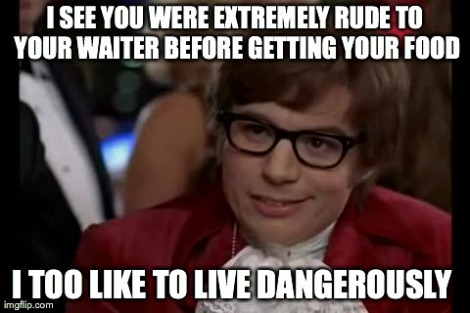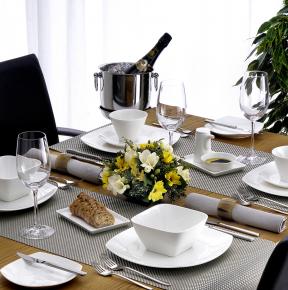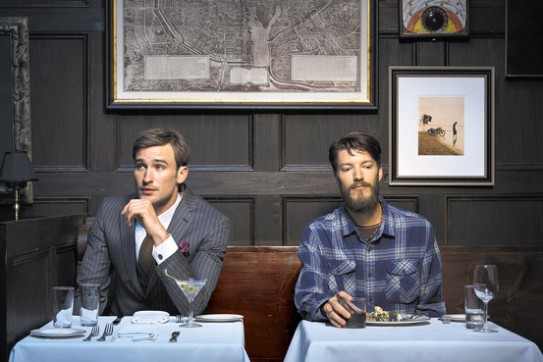As a lover of food, I obviously adore going out to eat in different places, sampling curious delights from creative menus designed by innovative chefs. But one of the things that spoils it for me is that my husband really doesn’t enjoy the fuss and ceremony of fine dining so won’t even contemplate going somewhere like that with me. He hates having his napkin broken and placed on his lap, he doesn’t like someone else pouring his water, and definitely doesn’t like to be called ‘Sir’.
For other people fine dining presents different obstacles, such as not knowing what utensil or piece of cutlery to use because there’s so many different types in front of you or wondering if it’s ok to pick up the leg of guinea fowl you’ve got on your plate because there’s not much meat but you paid for it and want the most you can get!
Having worked in fine dining myself, for Michelin-starred chef Nigel Haworth at his manor house hotel and restaurant, Northcote, I don’t feel any unease when being seated at a table with 3 different sets of cutlery, 3 types of glassware and so on, but I’ve got the distinct advantage of having been taught the etiquette whilst working in Front of House.
So to help you get by, (and with a bit of thought for waiting on staff in here too) here are my top tips for fine dining etiquette:
1) “Dress appropriately for the venue” – People tend to equate Michelin star ratings with establishments set up for formal fine dining but there are places such as Tom Kerridge’s Hand & Flowers in Marlow which markets itself as a gastropub but has 2 Michelin stars. Smart casual is usually a safe bet wherever, and both men and women should avoid wearing trainers, denim or sandals (unless heeled).
2) “Do not click your fingers at the waiter” – If you are in a good restaurant, your waiting staff should always be ready to serve customers who need assistance. However, on the occasions when service is busy or you’ve simply been ignored, a discreetly raised index finger should do the trick. It should ALWAYS be used alongside eye contact. A nod or a smile when you make eye contact doesn’t hurt either. Don’t raise your voice and call across the dining room or start flagging down a waiter with your menu and definitely don’t click your fingers to get your waiter’s attention. He is not a dog but he may bite your for the insult.
3) “If you’re the host, you pay” – Unless otherwise pre-arranged, it is common courtesy for the person who put out the invitation to pay for the meal and drinks. It is recommended that payment, or at least a payment card is handed over before being seated as this can remove any embarrassment or awkwardness that can potentially arise if payment has not been previously mentioned.
4) “Tip if you want” – A lot of places now operate by adding an optional gratuity of between 10-20% onto your bill which you are more than entitled to remove. Personally, no matter where I eat out, I take the gratuity off the bill (which is normally paid by card) and put cash directly into the hands of the server or waitress I want to tip. In the US tips make up wages; this practice was banned in the UK in 2009 but you never know!
5) “Sharing Platters are for sharing” – Unless you have been previously invited to do so, do not take food from your companion’s plate. This is especially important in formal dining situations. Many casual dining establishments offer sharing platters so obviously this is the place where crossing forks isn’t an issue.
6) “Complain if you need to” – A lot of diners I’ve met have said that they wouldn’t complain if their food wasn’t right or if some part of the service hadn’t been up to standard – they would simply rather not go back. However, how can a business improve if they don’t know what the problems are? Always send food back if it’s not been cooked properly; at the end of the day it’s your money and you would take back an electrical appliance if it wasn’t performing the way you expect it to. Why should our view on food consumerism be any different?
7) “Finished eating? Make sure your cutlery tells the same” – Basically the rule is this: if you are still eating but having a breather, place your knife and fork at about 4 and 8 (if your plate was a clock face). Once you have finished, the knife and fork should be placed together side by side on the plate.
8) “General Manners” – This is the most important rule for dining, especially when surrounded by other people who are also trying to enjoy their eating out experience. Use the napkin often. Cute your food up properly and don’t try stuffing it all in at once (unless you’re competing in a Man vs. Food style challenge!). Keep your elbows off the table and put mobiles and keys away. Finally, say please and thank you to your servers. It costs nothing but it can make a big difference to how they treat you.




